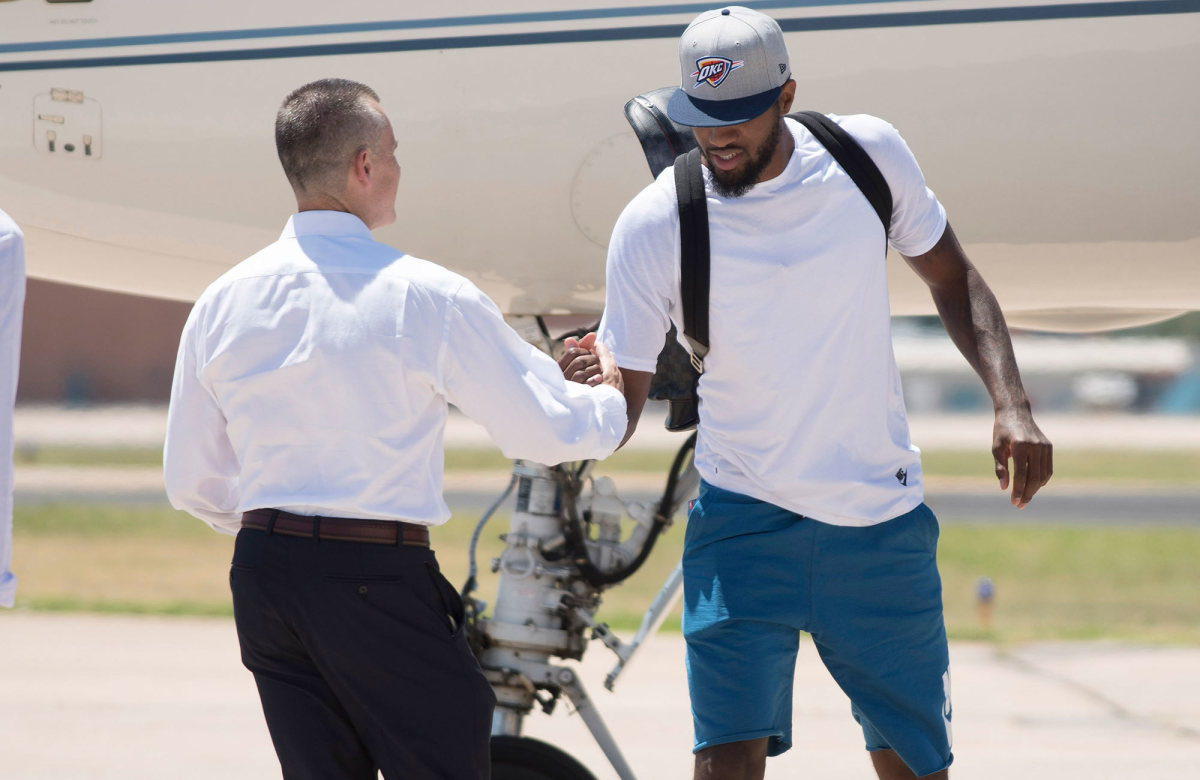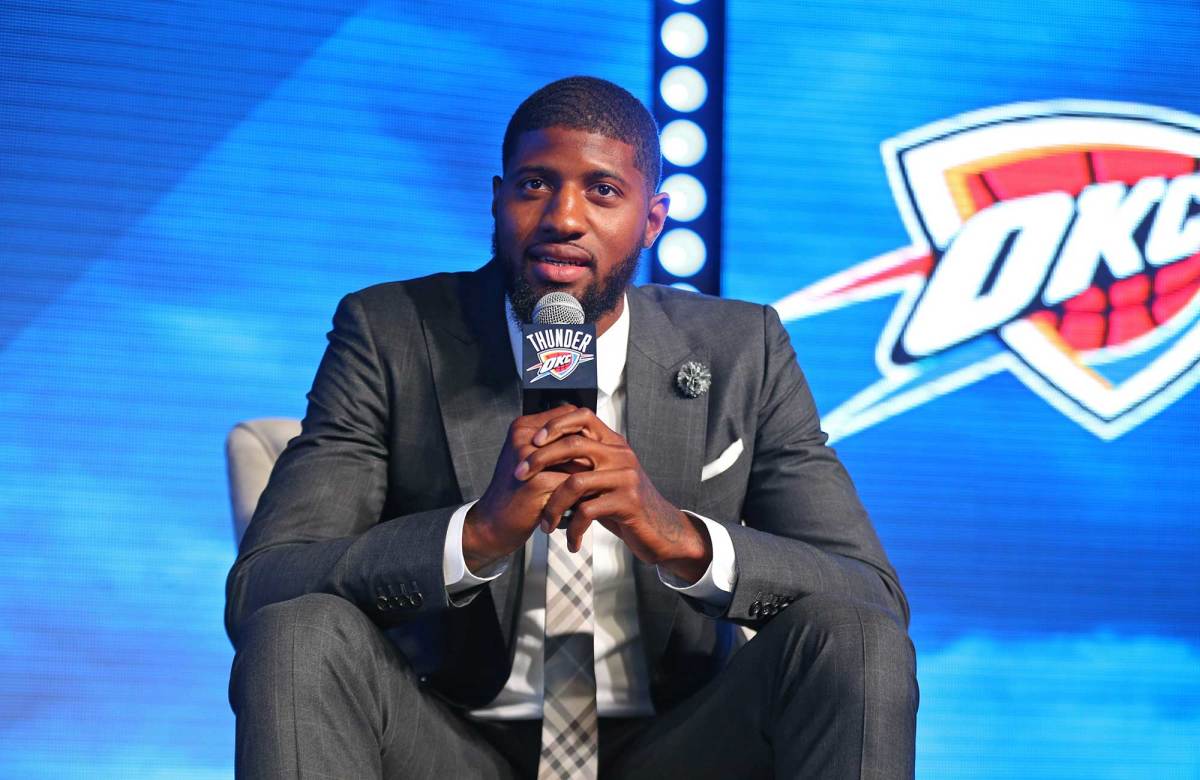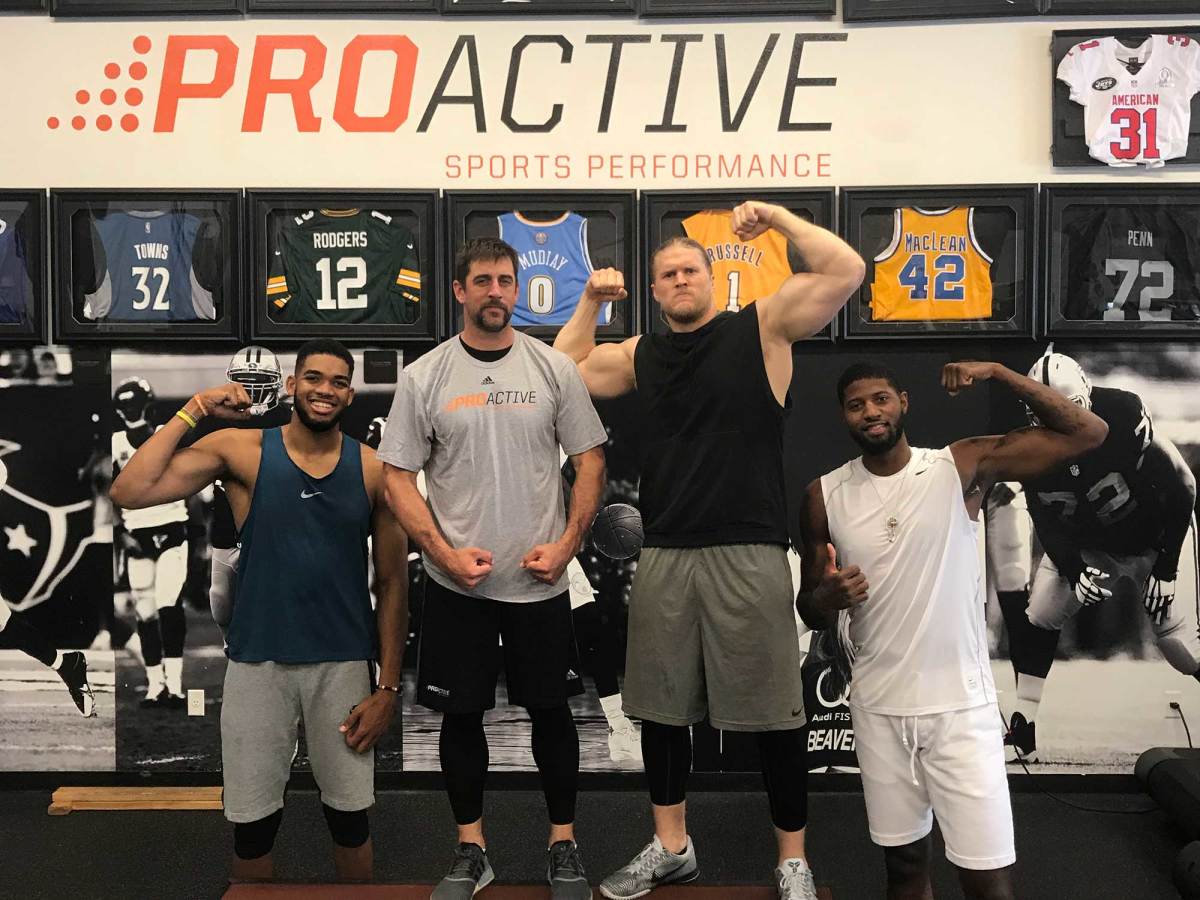Behind The Scenes Of Paul George's OKC Arrival

Paul George rode through downtown Oklahoma City in the first Suburban of a five-Suburban motorcade, late afternoon sun pouring through tinted windows, sidewalk drum line providing musical accompaniment. George folded his 6’9” frame into the backseat, white pocket square against gray suit, and marveled at how life can change even from within the same brand of SUV. George grew up in Palmdale, Calif., but his father came from Crosby, Tex., and his mother Lake Charles, La. In the summers, Paul and Paulette George rented a Suburban and hauled their three kids 23 hours east to reunions in Texas and Louisiana, where their only son would ride horses and fish with cousins and splash around creeks. Everybody called him Man because, as a baby, he held his bottle by himself, and as a 10-year-old, he slept at his mom’s bedside after she suffered a stroke. OKC’s muggy air, and its many lakes, reminded him of those childhood odysseys. “This has the same kind of feel,” George said. “It feels like home.”
With that, the new Man in Oklahoma City climbed out of the Suburban and strode into a two-story brick music hall that will soon host The Wallflowers and Willie Nelson, both of whom can only hope their concerts attract as boisterous a throng as the Paul George Welcome Party. George never took a recruiting visit in high school, at least not the kind any blue-chipper envisions. Coming out of Knight High and the Pump N’ Run AAU program—he and Klay Thompson anchored the wings for the B team—George made official visits to Pepperdine and Santa Clara, but committed to Fresno State before the big schools called. After two seasons in the Central Valley, he was drafted by Indiana, and at 22 he led the Pacers to the Eastern Conference finals. That summer, he did some promotional work for Gatorade, and during one radio interview an excitable host asked if he’d sign with the Lakers. George was still five years from unrestricted free agency, but he came from the outskirts of L.A. and idolized Kobe Bryant, biographical details that spawned irrational confidence he’d one day wear purple and gold.
Next July, George will finally be an unrestricted free agent, and he acknowledges that his hometown team holds much appeal. But in Oklahoma City he will be the subject of a yearlong recruiting effort beyond even John Calipari’s wildest imagination. The courtship started Tuesday, when George touched down on a private strip at Will Rogers World Airport, rocking a gray Thunder hat with a blue brim that he wore the week before to dinner in L.A. at Nobu Malibu. Head coach Billy Donovan and general manager Sam Presti were waiting on the tarmac to greet him, in suits, with a mob of fans behind them despite the highest temps of the summer. Thunder diehards have a history of flocking to the airport after landmark road trips, but according to one staffer, the swarm behind the chain link fence might have been the largest turnout since the return from Miami following the 2012 Finals.

Over the next 30 hours, George rode ATVs with his extended family at 640–acre Arcadia Farms, casting off from a boathouse dock into one of the 13 ponds stocked with bluegill, catfish and bass. (“I’d like to live on a lake,” George told a friend, “and bring my speedboat.”) He toured the Oklahoma City National Memorial, flinching at the recorded sound of the 1995 bombing, and examining the shoes of the children who died in the explosion. (“That alone is enough to feel a part of this and understand the reasoning for the support here.”) At the Colcord Hotel he slipped on his No. 13 Thunder jersey for the first time—“No, this is James Harden’s,” he cracked—and at Jones Assembly he answered questions on a stage from Lance Fresh as a standing-room crowd of 1,200 invited guests drank at an open bar. Every detail was choreographed, down to the David Sunflower Seeds and Fruit Gushers in the green room, which George chews religiously. By the time his motorcade headed back to the airport, past all the conveniently positioned welcome banners, George could sense that he means more than a standard 12-month rental.
He represents, for a spurned city, a resolute franchise and an MVP point guard, a second chance.
Three-hundred-seventy-three days after Kevin Durant signed with Golden State, Russell Westbrook made the hour-and-a-half drive from his youth camp in Tulsa to the Ambassador Hotel in Oklahoma City. Shortly before Durant announced his free-agent decision last summer, Westbrook went to dinner with his longtime teammate at BOA Steakhouse in L.A. and asked, "How can I change?". He didn’t get an answer, and a week later, Durant left for the Warriors while Westbrook played dominoes in his backyard during a July 4th party. Now Westbrook was on his way to meet another transformational two-way wing, perhaps not at Durant’s level but certainly in his class. On the flight to OKC, George played dominoes.
The NBA’s Fascinating And Frustrating Dilemma
Westbrook and George have little relationship but much common ground, L.A. natives and Kobe disciples who were largely overshadowed on Southern California’s hyper-intense recruiting trail. They come from tough backgrounds but two-parent homes and emerged as unlikely stars in a pair of the NBA’s smallest markets. When Westbrook arrived at O Bar, a narrow lounge with skyline views on the seventh floor of the Ambassador, George was at a table with family and friends, eating chicken wings with macaroni and cheese. Not coincidentally, the caterers knew his favorite comfort foods. Westbrook mingled with Thunder brass who had rented the place for the evening.
The MLB All-Star Game played on two TVs behind the bar, and soon enough, Westbrook was asking George why in the world he roots for the Mets instead of the Dodgers, which led to George mocking Westbrook’s Cowboys, which sparked riffs on UCLA basketball and the Mayweather-McGregor fight. They hung out for nearly four hours, until 11:45 p.m., Westbrook leaning against a gray pillar and George sitting on a white leather chair as his nephew dozed on a couch nearby. Associates considered calling cars earlier in the night, with Westbrook scheduled for a 6 a.m. flight to L.A., but he demurred.
This exchange reveals nothing about how Westbrook and George will function together, whether Westbrook will achieve more harmony with George than he did Durant, and if the July outcome will be any different. The question Westbrook put to Durant 13 months ago about changing did not have to be answered last season, when the Thunder needed his triple doubles and headlong rushes, but it does this fall. Fruit Gushers are sweet, but Westbrook remains OKC’s most valuable recruiting tool, and George is obviously seeking to join a union rather than witness a solo act.

The Thunder initially called the Pacers about George at the trading deadline in February, as did virtually every other team, and planned to reach out again after the season. When Oklahoma City was eliminated by Houston in the first round of the playoffs, Presti handed all his top lieutenants notecards with a picture of Richard Dean Anderson, the actor best known as MacGyver. The implication was obvious, at least to elders in the building. “We’ll have to use some tools we don’t have yet or some tools we haven’t had,” says director of basketball operations Paul Rivers, “and look from a perspective we haven’t had to look from before.” The Thunder did not possess a trove of draft picks, like the Celtics, but they did employ another kind of asset. When Durant bolted they made a conscious decision to invest in young controllable players, partly because they could be developed, but also because they could be traded far more easily than veterans.
Before the draft Presti called Pacers general manager Kevin Pritchard, who heard compassion in his counterpart’s voice. “I’ve been in this situation,” Presti told Pritchard. “It’s hard. I wish we weren’t talking about it.” Small-market GMs are a club within a club, united by the incessant concern that they’ll lose their best players to shiny metropolises promising superstar clusters. There are two ways to handle a headliner with wandering eyes. Trade him preemptively for less than he’s worth, as Presti did with Harden, or take him to free agency, as Presti did with Durant. Both options are awful.
Paul George On OKC, The Trade, And KD's Advice
Oklahoma City has always been a draft-and-develop organization, but the Warriors have changed the landscape of the league, turning it into what Rockets general manager Daryl Morey terms “a weapons race.” Twenty-year-olds, no matter how talented, are not taking down the Dubs. The Thunder faced a punishing choice. They could re-enter the arms race, a year after Durant, and risk getting gut-punched all over again. Or they could sit out, protecting raw emotions, and potentially squandering Westbrook’s prime. They did not pursue George as a way of convincing Westbrook to sign the five-year extension in front of him. They’ve always been confident he’ll ink it anyway. They chased George to give Westbrook, and themselves, another shot.
The NBA decompresses a bit after the draft, as front offices prepare for free agency July 1, but Oklahoma City kept in steady contact with Indiana. The Pacers liked two of the Thunder’s young regulars, 25-year-old shooting guard Victor Oladipo and 21-year-old power forward Domantas Sabonis. Most teams in the mix for George were trying to gauge whether they had a realistic chance to re-sign him next summer. The Thunder did not bother. Nobody who comes to Oklahoma City once a year can comprehend what it’s like to play there, anyway. But after six months of stocked ponds and standing ovations, Paul George will get the idea. It’s not for everybody. It probably isn’t for Kevin Durant; it probably is for Russell Westbrook.
In late June, Presti met with his staff and they agreed to place another bet on what they built.
As Westbrook piled up records last season, the Thunder studied the nature of the shots he creates, attempting to identify the type of reinforcements who fit best around him. If their computer could spit out a prototype, it might be a picture of Paul George, who can pass and shoot but doesn’t need the ball in his hands all the time. Typically, when a player of Durant’s stature departs, the guy who follows him into town is a teenage lottery pick unable to shoulder the burden. George is 27, a four-time All-Star who twice piggybacked the Pacers to the East finals, and is just three years removed from a gruesome broken leg sustained during a scrimmage with Team USA. Although George was dazzled by his intro to Oklahoma City—“Onboarding,” Thunder officials call their manner of orientation—he was not daunted.
George and the Thunder are equally familiar with the free-agent speculation that will hound them all winter, particularly on four jaunts to Los Angeles, but experience breeds comfort. “Last season I was mentally drained by it all,” George says. “As much as you try not to hear anything, it gets to you, and it’s a different kind of exhaustion. Game 60 felt like Game 100. I was running into the wall.” George’s performance through the first half of the season was pedestrian, bottoming out in February when he averaged 17.8 points and shot 38.9%. In early March, he overhauled his pregame routine, cutting back on shooting in favor of stretching and massage. Clearing his mind and preserving his body, George surged into the playoffs, averaging 26.4 points on 48.9% shooting after the break. When the Pacers lost to Cleveland in the first round, George took two weeks off, then showed up at the 5,000-square foot warehouse in L.A. where Packers linebacker Clay Matthews pumps his iron. “I needed to get stronger,” George says.

ProActive Sports Performance used to be a storage shed for motor homes, race cars and dirt bikes in Westlake Village until Ryan Capretta took over the space in 2006 and turned it into a garage gym beloved by soccer moms and pro football players. George worked out occasionally at ProActive last off-season, but he’s been there six days a week this summer, shoving 800-pound monster-truck tires and doing push-ups while covered with 120 pounds of metal chains. “He’s gotten to the point where he’s out-lifting some of these NFL guys,” says Capretta, a claim that may be disputed by Packers offensive tackle David Bakhtiari, who trades trash talk with George.
In different ways, Capretta and Bakhtiari are both preparing George for life with Russ, a relentless driver and yapper. George returns Oklahoma City to its natural basketball state: center Steven Adams setting high screens for Westbrook and rolling to the rim while George runs off pin downs from Andre Roberson, as Durant once did. Patrick Patterson, a stretch forward the Thunder pinpointed during their Westbrook research, will space the floor from the corner. George wants to see Oklahoma City reach the conference finals, which sounds farfetched in the brutal West, until you consider defections from the other contenders. George and Roberson rank among the finest wing defenders in the league, but George is particularly stingy against Harden, who shot 8 for 34 (3 of 19 from three) when Houston faced Indy last season.
In the end, Oklahoma’s bluegill won’t sway George, nor will L.A.’s red carpet. Like Chris Paul, Jimmy Butler and Gordon Hayward—who made similar off-season migrations—he yearns to trade blows with Golden State, as perilous as that may be. History shows it is easier to form a constellation on the coast, but Westbrook is in OKC and kids are in L.A. “I’m open,” George says, inspiring a sliver of hope in his new home and anxiety in his old one. For a quiet place, Oklahoma City is always interesting. Even last season, the Thunder ranked third in ESPN’s TV ratings to the Warriors and Cavs, and they might jump with George. For all the A-listers who switched sides recently, his move is the most dramatic, because of the backdrop and the stakes.
A year from now, the Thunder may be doubled over again, mourning the loss of a second superstar in three summers. Or they may be validated by a stretchy wing flourishing alongside Westbrook. Either way, they have boldly put themselves back in the Western Conference motorcade, opening their heart to another alluring headliner.
Next Man up.
